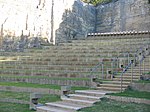City Beach, Western Australia

City Beach is a beachside suburb of Perth, Western Australia, located within the Town of Cambridge. Its postcode is 6015. It is also the name of a beach in the suburb. House prices are generally quite expensive. In 2020, City Beach had the fifth highest median house price in Perth, at $1.628 million.City Beach consists of three sections: a northern section (bordering Scarborough), a central section (bordering Wembley Downs and Floreat) and a southern section (bordering Bold Park). The centre part was built immediately prior to the 1962 British Empire and Commonwealth Games as an athletes' village due to its proximity to Perry Lakes Stadium in neighbouring Floreat.
Excerpt from the Wikipedia article City Beach, Western Australia (License: CC BY-SA 3.0, Authors, Images).City Beach, Western Australia
Templetonia Crescent, Town Of Cambridge
Geographical coordinates (GPS) Address Nearby Places Show on map
Geographical coordinates (GPS)
| Latitude | Longitude |
|---|---|
| N -31.934 ° | E 115.764 ° |
Address
Templetonia Crescent
Templetonia Crescent
6015 Town Of Cambridge, City Beach
Western Australia, Australia
Open on Google Maps






